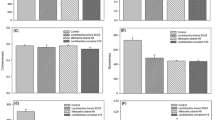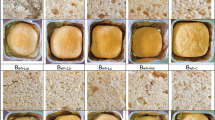Abstract
Effects of 8 different sourdoughs and their replacement levels at 10, 20, and 30%(w/w) on the volume (of dough), crust hardness, organoleptic, and anti-mold properties of Iranian sangak bread were investigated. Saccharomyces cerevisiae, Lactobacillus plantarum, Lactobacillus acidophilus, and Leuconostoc mesenteroides were selected for the preparation of sourdough samples. The highest dough volume was achieved when sourdough (those having S. cerevisiae) was used at 30%. The highest taste scores were found with the bread sample using the above-mentioned starters at 30% sourdough replacement level. Considering the chewing, appearance, and overall quality of the new products, most of the samples maintained the favorite sensory aspects of sangak bread. Use of lactic acid bacteria and yeast strains as part of the sourdough formulation (followed by the use of sourdough in the dough formulation) resulted in improved crust properties and greater anti-mold activities.
Similar content being viewed by others
References
Chavan RS, Chavan SR. Sourdough technology-a traditional way for wholesome foods: A review. Compr. Rev. Food Sci. F. 10: 170–183 (2011)
Dalié DKD, Deschamps AM, Richard-Forget F. Lactic acid bacteria-potential for control of mold growth and mycotoxins: A review. Food Control 21: 370–380 (2010)
Dal Bello F, Clarke CI, Ryan LAM, Ulmer H, Schober TJ, Ström K, Sjögren J, van Inderen D, Schnürer J, Arendt EK. Improvement of the quality and shelf life of wheat bread by fermentation with the antifungal strain Lactobacillus plantarum FST 1.7. J. Cereal Sci. 45: 309–318 (2005)
Corsetti A, Gobbetti M, Balestrieri F, Paoletti F, Russi L, Rossi J. Sourdough lactic acid bacteria effects on bread firmness and staling. J. Food Sci. 63: 347–351 (1998)
Wieser H, Vermeulen N, Gaertner F, Vogel RF. Effects of different Lactobacillus and Enterococcus strains and chemical acidification regarding degradation of gluten proteins during sourdough fermentation. Eur. Food Res. Technol. 226: 1495–1502 (2008)
Roghani D. Sangak Bread-the Study of Sociology. Aktaran Publications, Iran. pp. 34–35 (2007)
Reinhold JG. High phytate content of rural Iranian bread: A possible cause of human zinc deficiency. Am. J. Clin. Nutr. 24: 1204–1206 (1971)
Chaoui A, Faid M, Belhcen R. Effect of natural starters used for sourdough bread in Morocco on phytate degradation. East. Mediterran. Health J. 9: 141–147 (2003)
Lopez HW, Krespine V, Guy C, Messager A, Demigne C, Remesy C. Prolonged fermentation of whole wheat sourdough reduces phytate level and increases soluble magnesium. J. Agr. Food Chem. 49: 2657–2662 (2001)
Edema MO, Sanni AI. Functional properties of selected starter cultures for sour maize bread. Food Microbiol. 25: 616–625 (2008)
Gänzle MG, Loponen J, Gobbetti M. Proteolysis in sourdough fermentations: Mechanisms and potential for improved bread quality. Trends Food Sci. Technol. 19: 513–521 (2008)
AACC. Approved Method of the AACC. 9th ed. Method 54.21. American Association of Cereal Chemists, St. Paul, MN, USA (1995)
Zannini E, Garofalo C, Aquilanti L, Santarelli S, Silvestri G, Clementi F. Microbiological and technological characterization of sourdoughs destined for bread-making with barley flour. Food Microbiol. 26: 744–753 (2009)
de Man JC, Rogosa M, Sharpe ME. Medium for the cultivation of lactobacilli. J. Appl. Bacteriol. 23: 130–138 (1960)
AOAC.Official Method of Analysis of AOAC Intl. 17th ed. Method 925.09, 923.03, 920.87. Association of Official Analytical Communities, Horwitz W, MD, USA (2002)
Simonson L, Salovaara H, Korhola M. Response of wheat sourdough parameters to temperature, NaCl, and sucrose variations. Food Microbiol. 20: 193–199 (2003)
Palacios MC, Haros M, Sanz Y, Cristina RM. Selection of lactic acid bacteria with high phytate degrading activity for application in whole wheat bread making. Lebensm. -Wiss. Technol. 41: 82–92 (2008)
Chiavaro E, Vittadini E, Musci M, Bianchi F, Curti E. Shelf-life stability of artisanally and industrially produced durum wheat sourdough bread (’Altamura bread’). Lebensm. -Wiss. Technol. 41: 58–70 (2008)
Meilgaard M, Civille GV, Carr TB. Measuring responses. pp. 1–17. In: Sensory Evaluation Techniques. Meilgaard M, Civille GV, Carr BT (eds). CRC Press, Inc., Boca Raton, FL, USA (1999)
Fazeli MR, Shahverdi AR, Sedaghat B, Jamalifar H, Samadi N. Sourdough-isolated Lactobacillus fermentum as a potent anti-mold preservative of a traditional Iranian bread. Eur. Food Res. Technol. 218: 554–556 (2004)
Palacios MC, Sanz Y, Haros M, Rosell CM. Bifidobacterium strains as novel starters for breadmaking. Process Biochem. 41: 2434–2440 (2006)
Corsetti A, Settanni L. Lactobacilli in sourdough fermentation. Food Res. Int. 40: 539–558 (2007)
Arendt EK, Ryan LAM, Dal Bello F. Impact of sourdough on the texture of bread. Food Microbiol. 24: 165–174 (2007)
Zotta T, Ricciardi AM, Parente E. Enzymatic activities of lactic acid bacteria isolated from Cornetto di Matera sourdoughs. Int. J. Food Microbiol. 115: 165–172 (2007)
Decock P, Cappelle S. Bread technology and sourdough technology. Trends Food Sci. Tech. 16: 113–120 (2005)
Sterr Y, Weiss A, Schmidt H. Evaluation of lactic acid bacteria for sourdough fermentation of amaranth. Int. J. Food Microbiol. 136: 75–82 (2009)
Gobbetti M. The sourdough microflora: Interactions of lactic acid bacteria and yeasts. Trends Food Sci. Tech. 9: 267–274 (1998)
Gül H, Ozcelik S, Sagdic O, Certel M. Sourdough bread production with lactobacilli and S. cerevisiae isolated from sourdoughs. Process Biochem. 40: 691–697 (2005)
Gerez CL, Torino MI, Rollán G, de Valdez GF. Prevention of bread mold spoilage by using lactic acid bacteria with antifungal properties. Food Control 20: 144–148 (2009)
Valerio F, Lavermicocca P, Pascale M, Visconti A. Production of phenyllactic acid by lactic acid bacteria: An approach to the selection of strains contributing to food quality and preservation. FEMS Microbiol. Lett. 233: 289–295 (2004)
Author information
Authors and Affiliations
Corresponding author
Rights and permissions
About this article
Cite this article
Najafi, M.A., Rezaei, K., Safari, M. et al. Effects of several starter cultures on the anti-mold activity and sensory attributes of a traditional flat bread (Sangak) from Iran. Food Sci Biotechnol 21, 113–121 (2012). https://doi.org/10.1007/s10068-012-0014-4
Received:
Revised:
Accepted:
Published:
Issue Date:
DOI: https://doi.org/10.1007/s10068-012-0014-4




